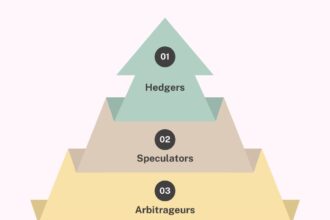Written By: Ansh Jain
There are three key players in options markets:-

Hedgers
Hedging in options is like buying insurance for your investments. It’s a way to protect yourself from huge losses if the price goes against you.
Here’s how it works
Imagine you own a stock, but you’re worried that the price might drop. You can buy a “put option” on that stock. A put option gives you the right, but not the obligation, to sell the stock at a certain price (called the “strike price“) within a certain time period.
If the stock price goes down below the strike price, you can exercise your option and sell the stock at the higher strike price, limiting your losses. If the stock price goes up, you don’t have to exercise the option, and you just lose the small amount of money you paid for it (called the “premium”).
Example
You hold a portfolio of stocks worth ₹10 lakhs, closely mirroring the Nifty 50 index, which is currently at 24,000. You anticipate a possible market downturn in the next month.
Hedging Strategy
To safeguard your portfolio, you decide to buy put options on the Nifty 50 index. Let’s choose a strike price of 23,900 expiring in one month. This gives you the right to sell Nifty at 23,900 even if the market drops further.
Possible Outcomes
- Market declines: If the Nifty falls to 23,500, your portfolio value decreases. But, your put options gain value because you can sell Nifty at 23,900, limiting your losses.
- Market remains stable or rises: If the Nifty stays around 24,000 or climbs higher, your portfolio either holds steady or appreciates. Your put options expire worthless, and you lose the premium you paid for them.
Example with numbers
- Nifty current level: 24,000
- Put option strike price: 23,900
- Premium paid per qty of put option: ₹150 (assuming each put option contract covers 50 qty of Nifty)
- Number of put option contracts bought: 20 (to cover your ₹10 lakh portfolio)
- Total premium paid: ₹30,000 (20 contracts x ₹150 per contract x 50 units)
Scenario 1: Nifty falls to 23,500
- Portfolio loss: (24,000 – 23,500) / 24,000 x ₹10,00,000 = -₹2,08,333 (approx)
- Put option gain: (23,900 – 23,500) x 50 units x 20 contracts = ₹4,00,000
- Net gain: ₹4,00,000 – ₹2,08,333 – ₹30,000 (premium) = ₹1,61,667 (approx)
Scenario 2: Nifty rises to 24,500
- Portfolio gain: (24,500 – 24,000) / 24,000 x ₹10,00,000 = ₹2,08,333 (approx)
- Put option loss: ₹30,000 (premium paid)
- Net gain: ₹2,08,333 – ₹30,000 = ₹1,78,333 (approx)
Key takeaway:
By using Nifty put options for hedging, you’ve effectively reduced the potential loss in a market downturn. This strategy allows for gains in a rising market but comes with the cost of the option premium.
Speculators
Speculation in options is like making a bet on the future price movement of an underlying asset (like a stock or an index). Instead of buying the asset itself, you’re buying the right to buy or sell it at a certain price within a certain timeframe.
- You believe the price will go UP: You buy call options. These give you the right to buy the asset at a specific price (the strike price). If the price goes up, your option becomes valuable, and you can make a profit by exercising it or selling it.
- You believe the price will go DOWN: You buy put options. These give you the right to sell the asset at a specific price. If the price goes down, your option becomes valuable.
Example
Reliance Industries is currently trading at ₹1300 per share. You believe that positive news regarding their green energy initiatives and 5G rollout will drive the price up significantly in the coming months.
Speculative Strategy
You decide to buy call options on RELIANCE with a strike price of ₹1400 and an expiration date of two months from now. This gives you the right (but not the obligation) to buy RELIANCE shares at ₹1400 anytime within the next two months.
Let’s say each call option contract costs ₹50 (and each contract covers 50 shares of RELIANCE).
Possible Outcomes
- Reliance price surges: If the market reacts positively to Reliance’s announcements, and the stock price climbs to ₹1600, your call options become valuable. You can exercise your options to buy shares at ₹1400 and immediately sell them at the market price of ₹1600, making a profit of ₹200 per share (minus the ₹50 premium you paid for the option).
- Reliance price stays flat or drops: If the market doesn’t react as you expect, and the stock price stays around ₹1300 or declines, your call options will expire worthless. You lose the ₹50 premium you paid per share.
Why this is speculation
- Directional Bet: You’re betting that RELIANCE’s price will rise above ₹1400.
- Leverage: Options provide leverage. With a smaller investment in options, you control a larger number of shares and can potentially magnify your profits (but also your losses).
- Limited Risk, Unlimited Potential: Your maximum loss is limited to the premium paid for the options. But your potential profit is unlimited if RELIANCE’s price goes way up.
- Time Decay: Options have an expiration date. Their value decreases as time passes, adding another layer of risk.
Arbitrageurs
Arbitrage in options involves taking advantage of pricing discrepancies between options and their underlying asset to lock in a risk-free profit. This is based on the principle of put-call parity, which states that the price of a call option plus the present value of the strike price should equal the price of a put option plus the current price of the underlying asset.
Example with HDFC Bank stock at ₹1750
Let’s assume the following:
- Current price of HDFC Bank stock: ₹1750
- Strike price of call and put options: ₹1800
- Call option price: ₹20
- Put option price: ₹60
- Risk-free interest rate: 5% (annualized)
- Time to expiration: 1 month (approx. 0.083 year)
Calculating the Present Value of the Strike Price
Since the options expire in one month, we need to discount the strike price to its present value.
Present Value = Strike Price / (1 + Risk-free Interest Rate)^(Time to Expiration)
Present Value = ₹1800 / (1 + 0.05)^(0.083) ≈ ₹1794
Checking for Mispricing
According to put-call parity:
Call Price + Present Value of Strike Price = Put Price + Current Stock Price
₹20+ ₹1794 = ₹60+ ₹1750
₹1814≠ ₹1810
This indicates a potential arbitrage opportunity. The call option appears to be overpriced relative to the put option.
Executing the Arbitrage
To exploit this mispricing, an arbitrageur would:
- Sell the overpriced call option: Receive ₹20
- Buy the underpriced put option: Pay ₹60
- Buy the HDFC Bank stock: Pay ₹1750
The arbitrageur’s net cash outflow: ₹60 + ₹1750 – ₹20 = ₹1790
At expiration
- If HDFC Bank price is above ₹1800: The call buyer will exercise their option, and the arbitrageur will need to buy the stock at ₹1800 to cover their short position. However, they can exercise their put option to sell the stock at ₹1800, resulting in no loss.
- If HDFC Bank price is below ₹1800: The call option will expire worthless. The arbitrageur can buy the stock at the lower market price to cover their short position and let the put option expire.
In both scenarios, the arbitrageur has locked in a risk-free profit of ₹1794 (present value of strike price) – ₹1790 (Net outflow) = ₹4.
| Feature | Hedging | Speculating | Arbitraging |
| Primary Goal | Reduce risk in existing investments | Profit from anticipated price movements | Exploit pricing inefficiencies for risk-free profit |
| Risk Level | Low to Moderate | High | Very Low (theoretically risk-free) |
| Profit Potential | Limited; tied to minimizing losses | Potentially high, but unlimited risk | Usually small, but guaranteed |
| Market View | Neutral or slightly bearish (if using puts) | Directional (bullish or bearish) | No specific market view required |
| Time Horizon | Typically matches the holding period of the underlying asset | Short-term to medium-term | Very short-term; often simultaneous transactions |
| Example | A farmer buys a put option to ensure he can sell wheat at ₹1,000 per quintal, protecting himself if prices drop. His goal is risk management, not profit. | An investor buys the same put option, betting that wheat prices will fall below ₹1,000 to make a profit. His goal is to capitalize on price movements. | A trader notices Reliance share priced at ₹1,300 on NSE and ₹1,310 on BSE. They buy on NSE and sell on BSE simultaneously, earning ₹10 per unit (minus costs) without taking any risk. |






